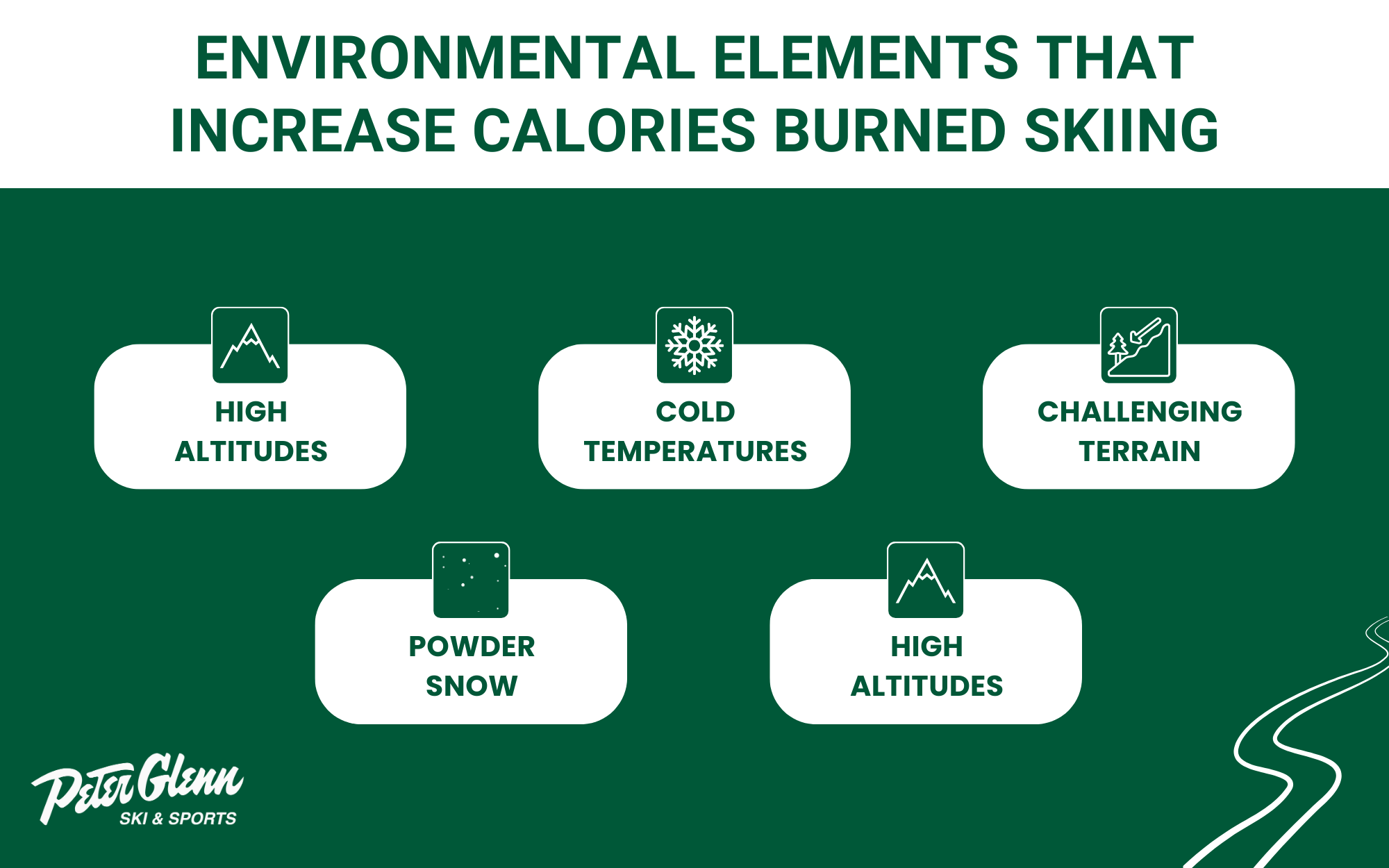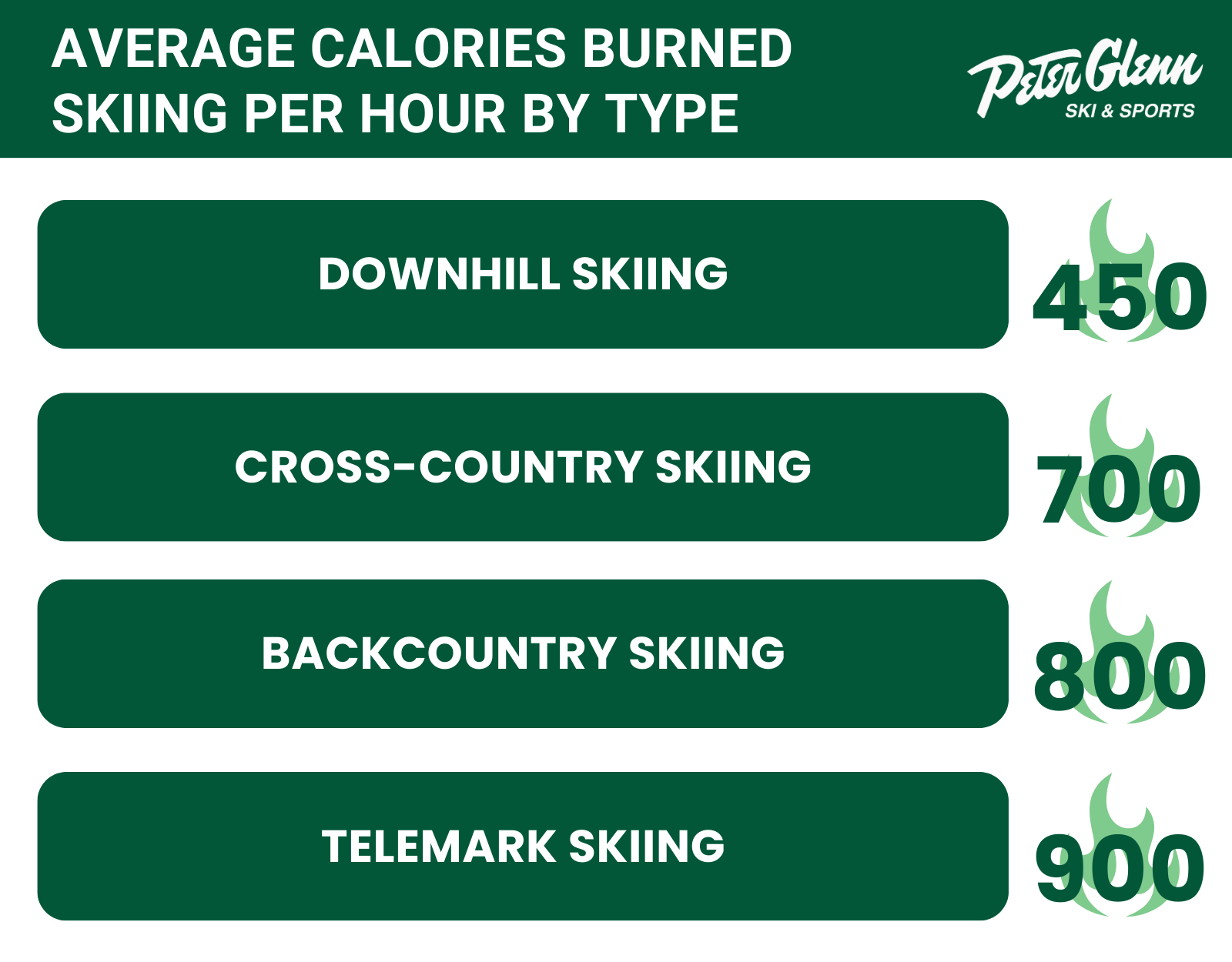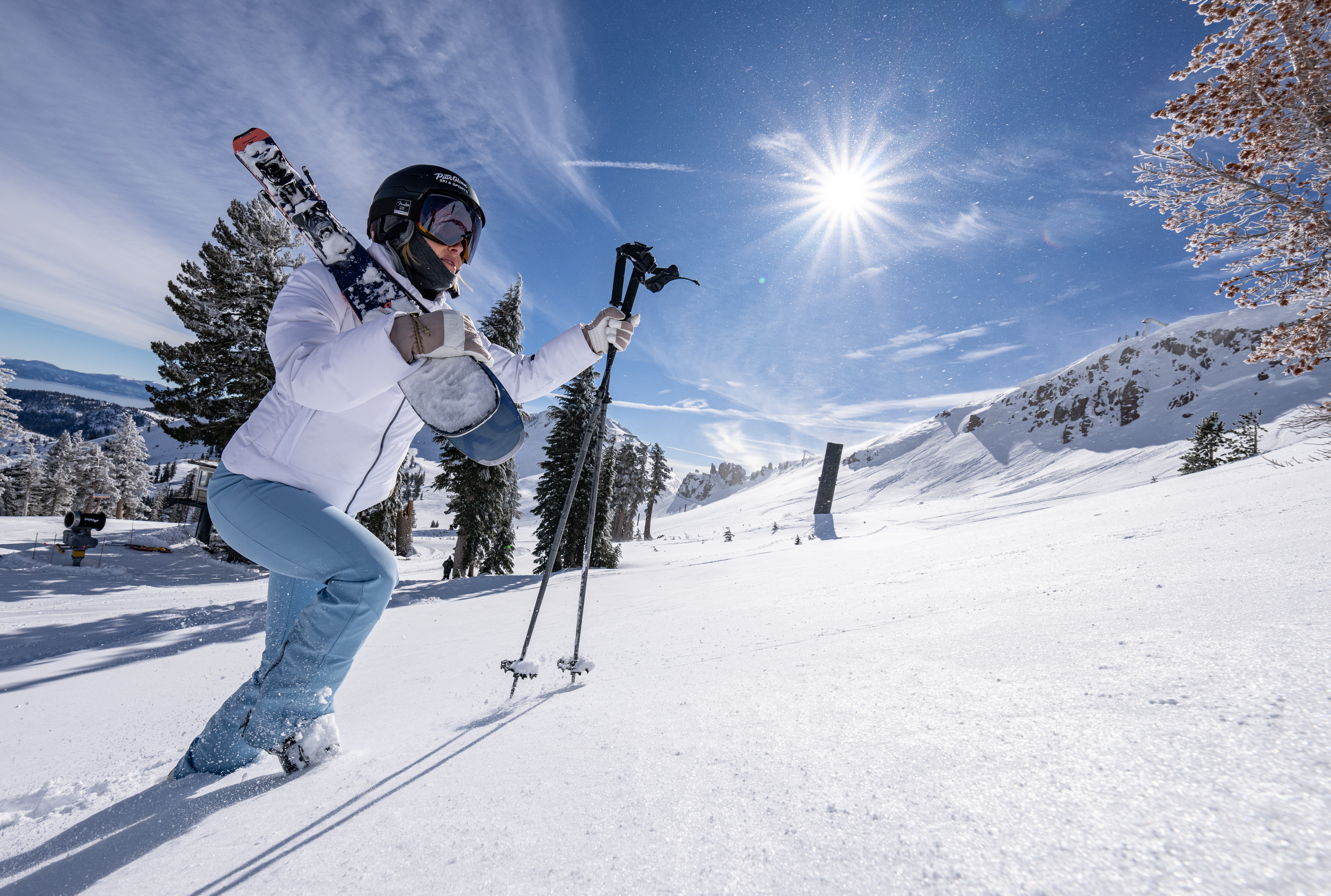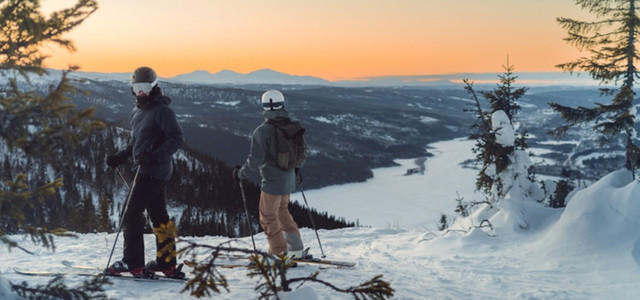Everything You Need to Know About Calories Burned Skiing
Posted by Peter Glenn Staff on Sep 22nd 2025
Table of Contents
The Short Answer: The average downhill skier burns between 300-600 calories per hour alpine skiing, and 500-900 calories per hour cross-country skiing, depending on body weight, terrain, and intensity. These calorie burn numbers can increase significantly with challenging terrain and higher intensity levels.
Skiing is a great way to stay active during the cold months while burning substantial calories. Whether you're gliding down groomed slopes at a ski resort or pushing through fresh powder on a backcountry trip, skiing works multiple muscle groups while providing an excellent workout for cardiovascular fitness. Different skiing styles and the intensity of your ride affect the number of calories you'll burn during your time on the snow.
Your calorie consumption while skiing varies based on several factors, including your body weight, chosen terrain, and skiing intensity. Understanding what to expect from different types of skiing and the health benefits that come with this dynamic winter sport help you maximize your workout on the slopes.
Factors Affecting Calorie Burn
Physical Factors
Your body composition and unique characteristics play a significant role in determining how many calories you burn while skiing. A higher body weight typically leads to greater calorie consumption; someone weighing 180 pounds will burn more calories than someone weighing 130 pounds doing the same physical activity. Your fitness level and skiing experience also influence energy expenditure. Newer skiers often burn more calories as their movements are less efficient and require more energy to maintain control.

Environmental Elements
Skiing at higher altitudes increases calorie burn as your body works harder to process oxygen in the thinner air. Cold temperatures also boost calorie expenditure since your body uses extra energy to maintain its core temperature. The type of challenging terrain you tackle matters as well. Steep slopes and off-piste skiing require more effort than groomed runs. Powder snow versus packed conditions can also affect how hard your body works, with deep powder typically demanding more energy.
Activity Variables
The intensity of downhill skiing directly impacts the amount of calories burned. Racing down black diamond ski runs burns more calories than casual cruising on green slopes. Your time on the slopes counts too, with longer sessions naturally leading to higher total calorie burn. It's also important to note that technical proficiency affects energy use. Advanced skiers who move efficiently may burn fewer calories during basic runs, but they can tackle more challenging terrain that increases overall burn. Taking frequent breaks reduces total calorie expenditure, while maintaining a steady pace with fewer stops maximizes the workout benefits.
Different Skiing Styles and Their Calorie Burns

Downhill Skiing
Alpine skiing and downhill skiing burn between 300-600 calories per hour, with the exact number of calories depending on your intensity level and technique. At a moderate pace, recreational downhill skiers typically burn 300-400 calories hourly while practicing controlled turns on groomed runs. More aggressive skiing, including racing techniques and challenging terrain, can increase the calorie burn rate to 400-600 calories per hour. Advanced skiers often burn more calories than beginners since they ski faster, tackle more demanding terrain, and maintain better form throughout their runs.
Cross-Country Skiing
Cross-country skiing offers an impressive calorie burn ranging from 500-900 calories per hour as a full-body workout. On flat terrain, cross-country skiers expend 500-600 calories hourly at a steady pace. When tackling varied terrain with hills, they can burn 700-900 calories per hour. This higher calorie burning comes from the continuous movement engaging core muscles and upper body strength, making cross country skiing one of winter's most effective physical activities. The pushing and pulling motions activate multiple muscle groups simultaneously.
Specialty Skiing Types
Backcountry skiing combines uphill climbing with downhill descents, burning 600-1,000 calories per hour due to the added body weight of safety gear and the demanding nature of breaking trail through unpacked snow. Telemark skiing, with its distinctive lunging turns, activates more muscle mass than traditional alpine skiing and can burn 600-800 calories per hour. The extra weight from specialized equipment like climbing skins, avalanche gear, and heavy boots adds to the caloric expenditure in these winter activities. Both styles demand more energy than ski resort skiing because they require constant adaptation to changing snow conditions and terrain.
Maximizing Your Ski Workout: Calorie Burn and Health Benefits
Tracking Methods
Modern technology makes it simple to monitor your skiing workout and calorie consumption. Most smart watches offer dedicated ski tracking modes that record runs, vertical descent, and calories burned during downhill skiing or cross country skiing. Popular options like Apple Watch, Garmin, and Suunto calculate energy expenditure using a combination of GPS data, elevation changes, and motion sensors.
Heart rate monitoring provides one of the most accurate ways to measure skiing intensity. Chest straps work better than wrist sensors in cold conditions and deliver consistent readings during dynamic movements. For a quick estimate, multiply your body weight in pounds by the metabolic equivalent (MET) value for your ski activity (downhill skiing = 5.3 METs, cross country skiing = 6.8-9.0 METs) and duration in hours.
Optimization Strategies
Mix up your skiing intensity to boost calorie burn. Modeling interval running exercises, alternate between 5-10 minutes of higher-intensity runs where you maintain a faster pace, followed by 3-5 minutes at a moderate pace for recovery. Choose challenging terrain that includes steeper sections and moguls to engage more muscle groups.
Aim for at least 2-3 hours of skiing to maximize cardiovascular fitness. Take shorter breaks between runs rather than long ski resort stops. Focus on proper form; keep your core muscles engaged, maintain an athletic stance, and use your poles actively during turns. These technique improvements make your skiing more efficient while increasing muscle activation.
Recovery Considerations
Skiing at higher altitudes in winter months increases fluid loss through breathing and sweating. Drink water every 60-90 minutes even if you don't feel thirsty. Pack easily digestible snacks like trail mix or energy bars to maintain blood sugar during longer sessions.
Allow adequate rest between challenging runs to prevent fatigue that can lead to poor form. Take a 5-10 minute break after every hour of continuous physical activity. This helps your muscles recover while keeping your body temperature regulated for optimal performance on the slopes.

Stay Fit with Peter Glenn
Downhill skiing and cross country skiing deliver an exceptional calorie-burning workout while providing a thrilling winter activity experience. The amount of calories burned during these activities vary based on your body weight, skill level, and challenging terrain. The combination of cardiovascular fitness, muscle groups strengthening, and exposure to fresh air makes skiing one of the season’s most rewarding physical activities.
In addition to providing a calorie-burning workout, skiing builds endurance, boosts balance, and strengthens multiple muscle groups simultaneously. Regardless of whether you choose downhill runs that challenge your core muscles and legs or cross country trails that provide a full body workout, you'll find an exercise that fits your fitness goals while delivering pure enjoyment on the slopes.
Ready to experience the health benefits of skiing? Shop Peter Glenn to explore skis, boots, jackets, and everything else you need to stay warm, comfortable, and ready for your next ski resort adventure.



